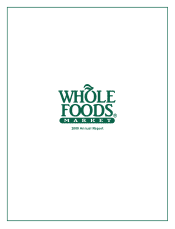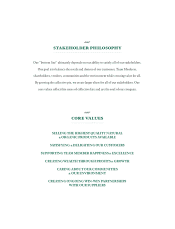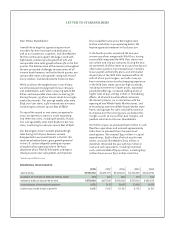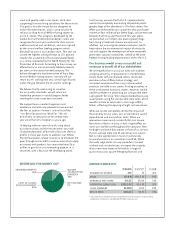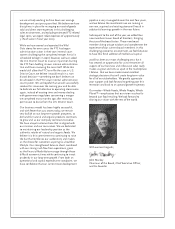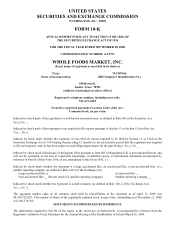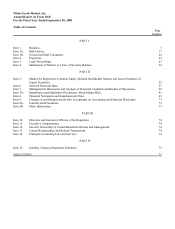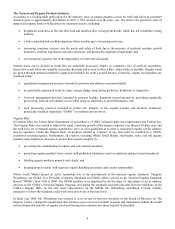Whole Foods 2008 Annual Report Download - page 4
Download and view the complete annual report
Please find page 4 of the 2008 Whole Foods annual report below. You can navigate through the pages in the report by either clicking on the pages listed below, or by using the keyword search tool below to find specific information within the annual report.
While we continued to produce healthy cash flow,
the negative impact of the challenging economic
environment on our sales and bottom line in the
second half of the year prompted us to take a
more conservative approach to our growth and
business strategy over the short term, which
included the following proactive measures:
We implemented certain cost-containment
measures at the global, regional and store
levels, including the elimination of 306
positions, saving an estimated $16 million in
labor and benefits annually.
We lowered our planned new store openings
for fiscal year 2009 to 15 from a prior range of
25 to 30. In addition, we terminated 13 leases
totaling approximately 679,000 square feet and
downsized nine leases by an average of 13,000
square feet each.
We cut all discretionary capital expenditure
budgets not related to new stores by 50%.
We suspended our cash dividend.
We sold $425 million of Series A Preferred Stock
to affiliates of Leonard Green & Partners, L.P.
The decision by Leonard Green & Partners, one
of the most experienced and successful retail
investors, to make such a significant investment
in our company is a strong vote of confidence in
our business model and future prospects. While
none of us can foresee how deep this recession
may go or how long it may last, we believe that
through these actions we now have adequate
liquidity to see us through these difficult times
and are better positioned to fulfill our core values
and realize our long-term growth potential.
We walk our talk when it comes to our core values.
Our first two Core Values are to sell the highest
quality natural and organic foods available and to
satisfy and delight our customers. This year, we were
recognized by Health magazine as the healthiest grocery
company in the U.S., and for the second year in a row,
we made Fortune’s list of “America’s Most Admired
Companies.” In the Food and Drug Stores category,
our peers ranked us #4 overall, with #1 rankings in
innovation, social responsibility, and quality of products.
High quality is one of Whole Foods Markets’
most important brand attributes and is what our
customers want and expect from us. In the current
economy, customers are also focused on stretching
their food dollars. Over the last several years we
have successfully increased the range of lower-
priced items offered within our grocery and Whole
Body departments, without sacrificing our quality
standards. Our hard work is producing returns,
as those departments have continued to produce
positive comparable store sale growth even as
consumers have become more value-conscious.
This year, we expanded our value push into our
perishable areas as well. In July, we launched our
Whole Deal program, which includes a quarterly
in-store guide providing specially-priced product
discounts, money-saving coupons and tips, as
well as budget-minded recipes. We believe that
strengthening our value image throughout the
store is the right strategy over the short and long
term, and while we know that we are not going to
change perceptions overnight, we believe that we are
gaining increasing credit for the values we offer, as
evidenced by many positive mentions in the media.
The product differentiation we experienced as
a business over our first twenty-eight years has
narrowed over the past several years. Driven in
large part by our success, the marketplace has
fundamentally changed, and there is a much
broader acceptance of the importance of healthy
foods. Today, most food retailers have competitively
evolved to incorporate many of our products and
practices, and new formats are being developed.
Our goal is to minimize the number of branded
grocery products in our stores that can also be
found in other places. We are making positive
strides in differentiating our product selection in
ways that speak to our core customers and to our
authenticity and leadership role within natural and
organic products, including expanding our exclusive
offerings in private label, control brands and
branded products. We launched our Whole Trade
product line two years ago, enabling customers
to use their buying power to help ensure a healthy
working environment for producers in developing
countries. We have more than doubled our offerings
under this line from 442 products last year to over
1,000 products today—ranging from bananas and
chocolate to cleaning products and body care items.
During the year we announced our newly-
enhanced farmed seafood standards, becoming
the first food retailer to require that our vendor
partners successfully pass an independent,
third-party audit to ensure compliance with our
standards. These enhanced standards were
created to minimize environmental impacts and
are the end result of two years of hard work by
our quality standards team. Greenpeace cited
our new quality standards as one of the factors
in Whole Foods Market once again being named
the nation’s #1 retailer in seafood sustainability.
We are committed to helping create alternatives
to the “factory farm” methods of raising livestock.
We have encouraged innovative animal production
practices to improve the quality and safety of the

